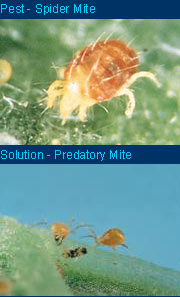|
|
|
|||||
|
|
||||||
|
||||||||||
|
Fast Growing Trees Fastest
Deciduous |
|
Faster
Deciduous |
|
Fast
Deciduous
Evergreen |
|
Fast Growing
Hedging Plants
Deciduous
Evergreen
Arborvitae
Douglas Fir |
|
Other unwelcome visitors: cats | foxes | frogs | moles :: pests and diseases | ants | aphids | blackspot | botrytis - gray mold | caterpillars | Japanese beetle larvae | leatherjackets | mealybugs | powdery mildew | red spider mite | rust | slugs and snails | vine weevils | whitefly |
|
|
 Signs
- Leaves
become speckled, as though covered with hundreds or thousands of pale yellow dots
giving a rather ill-looking and "dusty" appearance. Heavily infested plants
may become covered with fine webs. The red spider mites themselves are eight legged
animals less than 1mm long and can be difficult to see.
Signs
- Leaves
become speckled, as though covered with hundreds or thousands of pale yellow dots
giving a rather ill-looking and "dusty" appearance. Heavily infested plants
may become covered with fine webs. The red spider mites themselves are eight legged
animals less than 1mm long and can be difficult to see.
Damage - Sap feeders which weakens the plant. Usually a problem in house and greenhouse plants as they like a dry atmosphere, can be a problem outside in hot, dry summers.
Treatment - Red spider mites breed in hot and dry places. If you can increase the humidity around the plant you decrease the pest's reproduction rate. In greenhouses and patio areas the floors can be damped down. For house plants a short holiday somewhere cooler and more humid - the bathroom? may help get rid of the infestation.
You could try giving them cold water baths, they hate them. Spray them with water that is between 0°C and 5°C - make sure the plant won't also hate it though!). If you find an infested plant, attack it with ice water. Keep a spray bottle in the refrigerator and mist once or twice a day until the mites are all gone.
The rapid reproductive rate and the existence of pesticide resistant strains makes control difficult. Insecticidal soaps sprayed every three days may help control infestations if not eradicate them.
Another option is to go for biological control. Biological control of a pest relies on introducing a predator species so "fighting nature with nature", if chosen carefully, the predator will stop damage to your plants without damaging the environment. Such biological controls are safe for the user, children and pets. They will not harm other beneficial garden insects and are biodegradable.
They do rely on the predator always having some food though, or they will die out, so like other organic practices it is a question of maintaining a small population of pests to allow the predators to be ready for them, in this case though the balance is skewed away from the problem.
Biological control for red spider
mites is a predatory mite; Phytoseiulus permilis. This insect reproduces
at twice the speed of red spider mite at 18°c (64°f). The Phytoseiulus mite
eats only Red spider mite and each can eat many hundreds of them. Whilst feeding
on Red spider mite, Phytoseiulus will also reproduce laying many eggs which
will hatch into more predators. Phytoseiulus is similar in appearance to
red spider mite but is more red in color and moves much faster.
Phytoseiulus is suitable for glasshouse or conservatories and can be used on strawberries
and fruit from May to August outside.
| I've been having trouble with Red Spider Mite in
my conservatory for a couple of years, using conventional and biological
pest control. I then tried your idea of spraying infected plants with
ice water. Brilliant results! - Thanks. Jon Willis - by email |
|
|
|
About us. General queries and emails to |
|
Copyright © Paul Ward 2000 - 2012 |